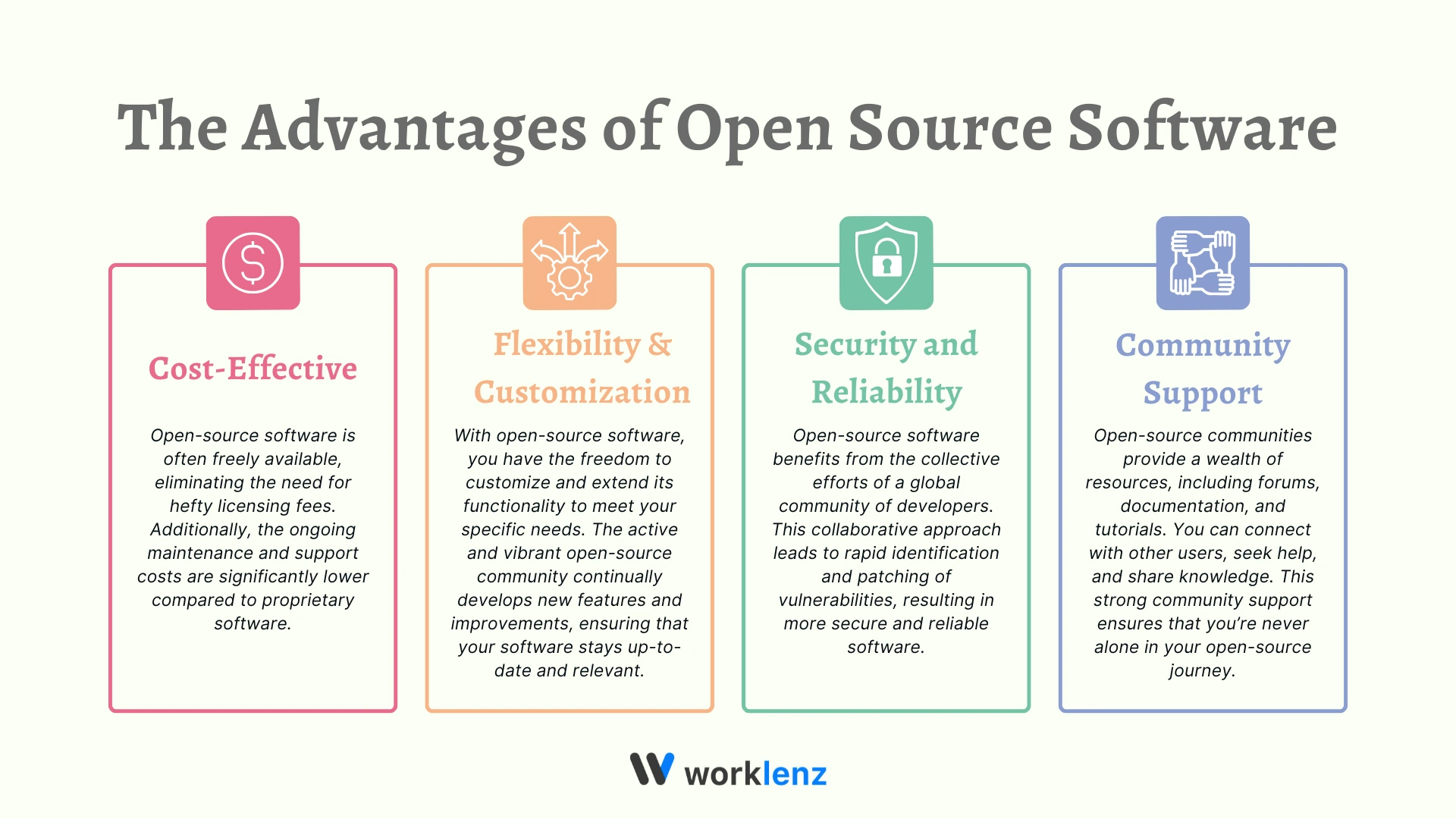
Conteúdo: >Você sabia que as empresas gastam bilhões anualmente em licenças de software proprietário, com custos previstos para aumentar de 10 a 15% a cada ano?
Embora o software proprietário possa oferecer conveniência, ele vem com despesas ocultas, como taxas de licenciamento recorrentes, bloqueio de fornecedor e falta de personalização. Em contraste, soluções de código aberto, como o Worklenz, oferecem flexibilidade, controle e economia de custos, ajudando as empresas a evitar as armadilhas dos sistemas proprietários e a assumir o controle de seu ambiente de software.
O software proprietário geralmente vem com custos ocultos que as empresas podem não reconhecer imediatamente. Embora o preço inicial possa parecer justificado, taxas de licenciamento recorrentes, bloqueios de fornecedores a longo prazo e falta de flexibilidade podem impactar significativamente o seu resultado final. O software de código aberto, em contraste, remove essas barreiras, oferecendo soluções econômicas que são altamente personalizáveis. A capacidade de modificar e distribuir software de código aberto livremente não só ajuda as empresas a reduzir custos, mas também permite um maior controle sobre o ambiente de software.
Software de código aberto é um tipo de software cujo código fonte está disponível gratuitamente para o público. Isso significa que qualquer pessoa pode visualizar, modificar e distribuir o software. Projetos de código aberto são frequentemente desenvolvidos por comunidades de programadores que colaboram para melhorar o software.
Exemplos populares de software de código aberto incluem,
Linux - Um sistema operacional popular que alimenta milhões de servidores e desktops em todo o mundo.
Apache - Um poderoso servidor web que alimenta uma parte significativa da internet.
WordPress - Um sistema de gerenciamento de conteúdo flexível usado por milhões de sites.
Software proprietário, também conhecido como software comercial, é um software que é de propriedade de uma empresa específica. O código fonte do software proprietário não está disponível publicamente, e os usuários normalmente têm que comprar licenças para usá-lo.
Exemplos comuns de software proprietário incluem,
Microsoft Windows
Adobe Creative Suite
Microsoft Office
Agora que estabelecemos o básico, vamos explorar as muitas vantagens do software de código aberto.
Embora o software proprietário possa parecer conveniente à primeira vista, muitas vezes vem com custos ocultos que podem impactar significativamente o seu orçamento.
O software proprietário geralmente requer taxas de licença recorrentes, que podem se acumular ao longo do tempo.
Manter o software proprietário atualizado e seguro pode envolver custos adicionais para atualizações, patches e suporte técnico.
O software proprietário pode limitar suas opções e vinculá-lo a um fornecedor específico.
Migrar para uma solução de software diferente pode ser demorado e caro.
O software proprietário geralmente oferece opções limitadas de personalização, tornando difícil adaptar o software às suas necessidades específicas.
Você pode precisar contar com o fornecedor para atualizações, correções de bugs e novos recursos.
Vamos aproveitar um momento para explorar as muitas vantagens do software de código aberto, que pode ajudá-lo a economizar dinheiro, aumentar a flexibilidade e melhorar a segurança.
O software de código aberto oferece uma infinidade de benefícios que podem impactar significativamente o seu negócio.

Custo-efetivo - O software de código aberto geralmente está disponível gratuitamente, eliminando a necessidade de taxas de licença pesadas. Além disso, os custos contínuos de manutenção e suporte são significativamente menores em comparação com o software proprietário.
Flexibilidade e Personalização - Com o software de código aberto, você tem a liberdade de personalizar e estender sua funcionalidade para atender às suas necessidades específicas. A comunidade de código aberto, ativa e vibrante, desenvolve continuamente novos recursos e melhorias, garantindo que seu software permaneça atualizado e relevante.
Segurança e Confiabilidade - O software de código aberto se beneficia dos esforços coletivos de uma comunidade global de desenvolvedores. Essa abordagem colaborativa leva à identificação e correção rápidas de vulnerabilidades, resultando em um software mais seguro e confiável.
Suporte da Comunidade - As comunidades de código aberto fornecem uma riqueza de recursos, incluindo fóruns, documentação e tutoriais. Você pode se conectar com outros usuários, buscar ajuda e compartilhar conhecimento. Esse forte suporte da comunidade garante que você nunca está sozinho em sua jornada de código aberto.
Agora que exploramos o básico, vamos entrar no emocionante mundo do software de código aberto.
Escolher entre software de código aberto e proprietário pode ser uma tarefa assustadora. Para tomar uma decisão informada, considere os seguintes fatores,
Avaliando Suas Necessidades Específicas
Defina claramente as necessidades e objetivos específicos da sua organização.
Pesquise soluções de código aberto e proprietárias que estejam alinhadas com suas necessidades.
Escolha uma solução que possa escalar com o seu negócio à medida que ele cresce.
Entendendo Questões de Compatibilidade
Certifique-se de que o software escolhido pode se integrar perfeitamente aos seus sistemas existentes.
Verifique a compatibilidade com sua infraestrutura de hardware.
Avaliando Custos Ocultos
Considere os custos a longo prazo, incluindo taxas de licença, manutenção e suporte.
Avalie a disponibilidade de recursos de treinamento e suporte técnico para software de código aberto e proprietário.
Você pode tomar uma decisão informada que maximiza os benefícios do software de código aberto, minimizando os riscos potenciais.
O software de código aberto percorreu um longo caminho, e seu futuro parece promissor. À medida que a tecnologia continua a evoluir, as soluções de código aberto estão se tornando cada vez mais sofisticadas e poderosas.
Inovação Impulsionada pela Comunidade: As comunidades de código aberto estão constantemente colaborando para desenvolver soluções inovadoras e enfrentar desafios emergentes.
Adoção Empresarial Aumentada: Cada vez mais empresas estão adotando software de código aberto para reduzir custos, melhorar a flexibilidade e aumentar a segurança.
A Ascensão do Hardware de Código Aberto: O hardware de código aberto, como o Raspberry Pi e o Arduino, está capacitando indivíduos e organizações a criar soluções personalizadas.
Você pode dar à sua empresa uma vantagem competitiva ao adotar software de código aberto. É uma ferramenta poderosa que pode ajudá-lo a inovar mais rápido, reduzir custos e se manter à frente da curva.
Em conclusão, o software de código aberto oferece uma alternativa atraente ao software proprietário tradicional. Ao entender os benefícios e desafios de ambas as abordagens, você pode tomar decisões informadas que estão alinhadas com os objetivos de sua empresa.
Abrace o poder do software de código aberto para desbloquear a inovação, reduzir custos e aumentar a competitividade de sua empresa. Ao se juntar à vibrante comunidade de código aberto, você pode contribuir para o desenvolvimento de tecnologias de ponta e moldar o futuro do software.